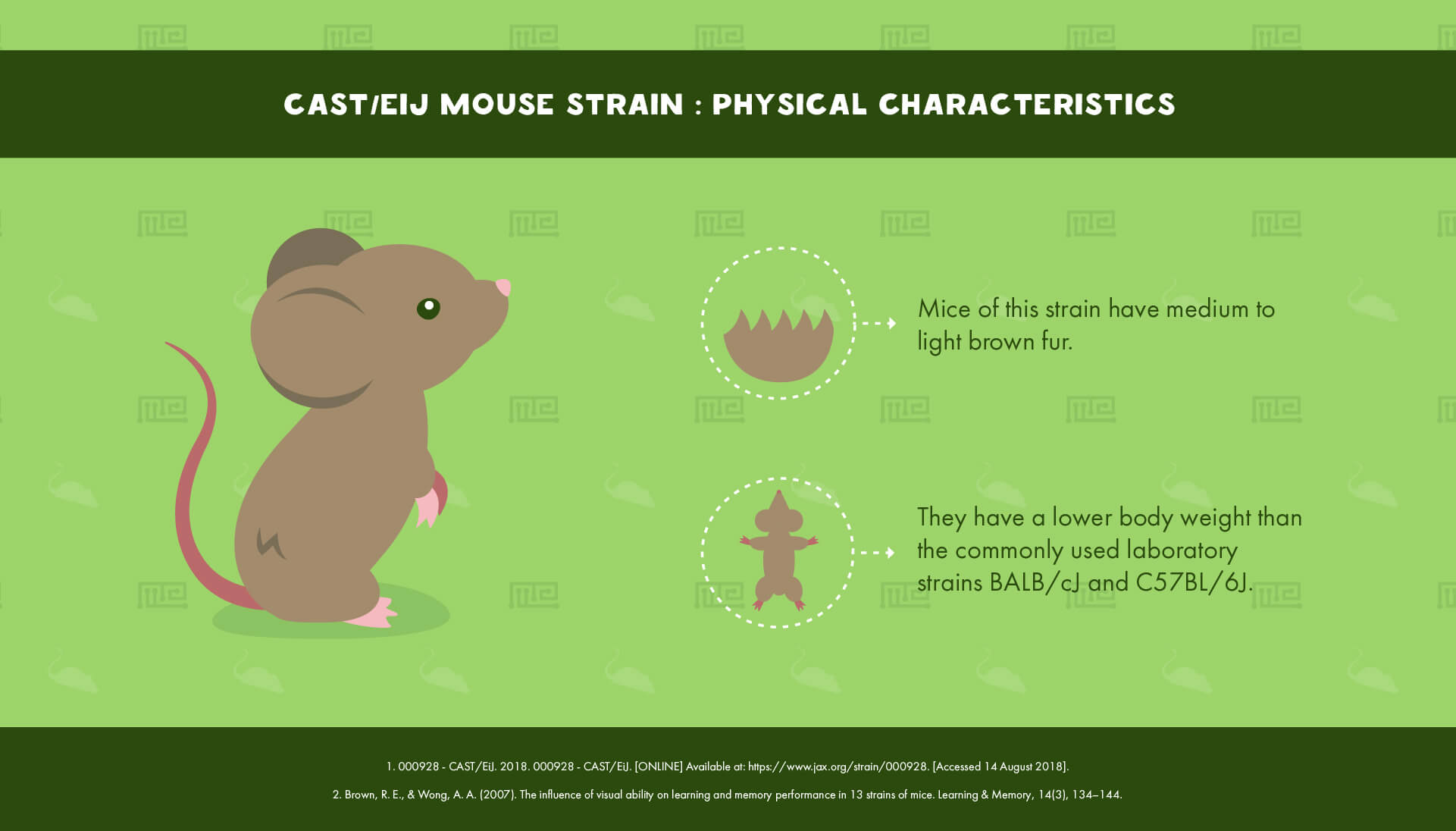Overview
The CAST/EiJ is a wild inbred strain of mouse model that exhibits marked phenotypic differences from the most common laboratory strains in a way that makes it especially useful for genetic and evolutionary biological research.[1]
History
The original CAST strain was derived from mice that were found trapped in a grain warehouse in Thailand by Dr. Joseph Marshall. The CASA/Rk strain shares this same lineage. Marshall sent the mice to Yale University, from which they were taken to the Jackson Laboratory in 1971.[1][2]
Inbreeding in Dr. Eva Eicher’s lab at the Jackson Laboratory created the current CAST/EiJ strain. Many labs have since used the CAST/EiJ to create a range of special purpose hybrids.[1]
Behavioral Characteristics & Handling
As a wild strain, CAST/EiJ would not be expected to behave similarly to the most common laboratory strains, and thus caution would generally be advised. A Canadian study[4] comparing the ease of handling of various strains rated the CAST/EiJ as one of the least placid of the 21 strains measured. These mice showed greater than usual struggling and evasive behavior during capture and holding, although squeaking was not very frequent.
CAST/EiJ mice have been seen to travel a large distance in the open field test.[5] Another study reports intermediate shelter visit duration and activity bout duration during monitoring of free locomotor activity in the mouse enclosure. These reports suggest that mice of this strain exhibit medium to high activity.[6]
CAST/EiJ mice show a higher preference for carbohydrate than for fat, the opposite of the preference displayed by the C7BL/6J strain, which the researchers interpret as a possible difference in fat taste sensation.[7]
One study reports that CAST/EiJ performed worse in the Morris water maze (a test of spatial learning and memory) than a number of common strains, including C57BL/6J and DBA/J, suggesting they may have spatial learning deficits. The strain’s performance on the rotarod could not be measured in this study as the mice repeatedly jumped off the apparatus.[3] Experimenters wishing to assess the motor functions of this strain may want to opt for an alternative paradigm.
Health Characteristics
Unlike most laboratory mouse strains, CAST/EiJ mice are resistant to infection by flavirus, meaning they cannot develop dengue, yellow fever or certain kinds of encephalitis. The resistance is conferred by a mutation in the enzyme oligoA synthase.[1]
Neurons in both the peripheral and central nervous system of these mice have an impressive regenerative capacity. Damaged dorsal root ganglions of CAST/EiJ regenerate much more extensively in an inhibitory environment than those of other strains, and this is also seen with the spinal cord and optic nerve.[1]
CAST/EiJ mice possess a mutant allele Ahrd of the aryl hydrocarbon receptor, which is involved in the regulation of the CYP1A1 metabolic enzyme. The mutant allele confers a much weaker ligand binding affinity than the equivalent receptors in mice of the C57BL/6J strain.[1]
Major Experimental Uses
Due to their marked differences at a great number of genetic loci from standard laboratory mouse strains, wild strains such as CAST/EiJ have proven most useful in genetic mapping, systematics, and evolutionary biology.[1][2]
CAST/EiJ mice’s possession of the mutant aryl hydrocarbon receptor gene has also meant they find an application in research on metabolic abnormalities.[1]
References
- 000928 – CAST/EiJ. 2018. 000928 – CAST/EiJ. [ONLINE] Available at: https://www.jax.org/strain/000928. [Accessed 14 August 2018].
- MGI – Inbred Strains: CAST. 2018. MGI – Inbred Strains: CAST. [ONLINE] Available at: http://www.informatics.jax.org/inbred_strains/mouse/docs/CAST.shtml. [Accessed 14 August 2018].
- Brown, R. E., & Wong, A. A. (2007). The influence of visual ability on learning and memory performance in 13 strains of mice. Learning & Memory, 14(3), 134–144.
- Wahlsten, D. Metten, P. Crabbe, JC. 2003. A rating scale for the wildness and ease of handling laboratory mice: results for 21 inbred strains tested in two laboratories. Genes, Brain and Behavior. 2; 71-79.
- Fonio, Y. Benjamini, A. Sakov and I. Golani. Wild mouse open field behavior is embedded within the multidimensional data space spanned by laboratory inbred strains. Genes, Brain and Behavior (2006) 5: 380–388.
- Loos M, Koopmans B, Aarts E, Maroteaux G, van der Sluis S, Neuro-BSIK Mouse Phenomics Consortium, et al. (2014) Sheltering Behavior and Locomotor Activity in 11 Genetically Diverse Common Inbred Mouse Strains Using Home-Cage Monitoring. PLoS ONE 9(9).
- Anthony Sclafani, Austin S.Vural, KarenAckroff. Profound differences in fat versus carbohydrate preferences in CAST/EiJ and C57BL/6J mice: Role of fat taste. Physiology & Behavior. Volume 194, 1 October 2018, Pages 348-355.


